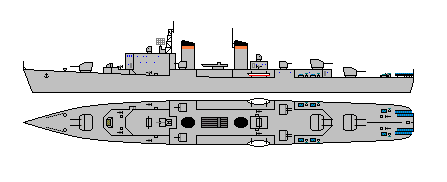Went back and re-jigged the Rawalpindis. As Brock had indicated, getting everything on to the hull in question was an iffy proposition given that I was setting aside "B" position for the Mangus ASW system.
So I ended up tossing a torpedo carriage and reducing two of the 57mm guns from twins to singles.
I can probably find room on either side of the aft funnel for torpedo reloads, which would be reasonable given that there's only one carriage on the boat.
The sketch below is preliminary and incomplete, but you get the idea.

Enter ship name, Enter country Enter ship type laid down 1944
Displacement:
2,091 t light; 2,222 t standard; 2,546 t normal; 2,805 t full load
Dimensions: Length overall / water x beam x draught
390.74 ft / 379.10 ft x 42.65 ft x 13.12 ft (normal load)
119.10 m / 115.55 m x 13.00 m x 4.00 m
Armament:
6 - 4.92" / 125 mm guns (3x2 guns), 59.59lbs / 27.03kg shells, 1944 Model
Dual purpose guns in deck mounts with hoists
on centreline ends, majority aft, 1 raised mount aft - superfiring
4 - 2.24" / 57.0 mm guns (2x2 guns), 5.65lbs / 2.56kg shells, 1944 Model
Dual purpose guns in deck mounts
on side, all amidships, all raised mounts - superfiring
2 - 2.24" / 57.0 mm guns in single mounts, 5.65lbs / 2.56kg shells, 1944 Model
Dual purpose guns in deck mounts
on side, all amidships, all raised mounts - superfiring
8 - 0.98" / 25.0 mm guns (4x2 guns), 0.48lbs / 0.22kg shells, 1944 Model
Machine guns in deck mounts
on side, evenly spread, all raised mounts
Weight of broadside 395 lbs / 179 kg
Shells per gun, main battery: 350
5 - 21.7" / 550 mm above water torpedoes
Armour:
- Gun armour: Face (max) Other gunhouse (avg) Barbette/hoist (max)
Main: 1.97" / 50 mm 0.79" / 20 mm 1.97" / 50 mm
3rd: 0.98" / 25 mm 0.39" / 10 mm -
4th: 0.98" / 25 mm 0.39" / 10 mm -
5th: 0.39" / 10 mm - -
Machinery:
Oil fired boilers, steam turbines,
Geared drive, 2 shafts, 48,258 shp / 36,000 Kw = 34.38 kts
Range 7,000nm at 15.00 kts
Bunker at max displacement = 583 tons
Complement:
178 - 232
Cost:
£1.837 million / $7.347 million
Distribution of weights at normal displacement:
Armament: 49 tons, 1.9 %
Armour: 30 tons, 1.2 %
- Belts: 0 tons, 0.0 %
- Torpedo bulkhead: 0 tons, 0.0 %
- Armament: 30 tons, 1.2 %
- Armour Deck: 0 tons, 0.0 %
- Conning Tower: 0 tons, 0.0 %
Machinery: 1,131 tons, 44.4 %
Hull, fittings & equipment: 738 tons, 29.0 %
Fuel, ammunition & stores: 455 tons, 17.9 %
Miscellaneous weights: 142 tons, 5.6 %
Overall survivability and seakeeping ability:
Survivability (Non-critical penetrating hits needed to sink ship):
811 lbs / 368 Kg = 13.6 x 4.9 " / 125 mm shells or 0.4 torpedoes
Stability (Unstable if below 1.00): 1.20
Metacentric height 2.0 ft / 0.6 m
Roll period: 12.8 seconds
Steadiness - As gun platform (Average = 50 %): 60 %
- Recoil effect (Restricted arc if above 1.00): 0.35
Seaboat quality (Average = 1.00): 0.87
Hull form characteristics:
Hull has a flush deck
and transom stern
Block coefficient: 0.420
Length to Beam Ratio: 8.89 : 1
'Natural speed' for length: 22.68 kts
Power going to wave formation at top speed: 69 %
Trim (Max stability = 0, Max steadiness = 100): 69
Bow angle (Positive = bow angles forward): 20.00 degrees
Stern overhang: 3.28 ft / 1.00 m
Freeboard (% = measuring location as a percentage of overall length):
- Stem: 22.97 ft / 7.00 m
- Forecastle (20 %): 19.03 ft / 5.80 m
- Mid (50 %): 15.09 ft / 4.60 m
- Quarterdeck (15 %): 15.09 ft / 4.60 m
- Stern: 15.09 ft / 4.60 m
- Average freeboard: 16.78 ft / 5.12 m
Ship space, strength and comments:
Space - Hull below water (magazines/engines, low = better): 166.4 %
- Above water (accommodation/working, high = better): 138.6 %
Waterplane Area: 10,465 Square feet or 972 Square metres
Displacement factor (Displacement / loading): 84 %
Structure weight / hull surface area: 41 lbs/sq ft or 198 Kg/sq metre
Hull strength (Relative):
- Cross-sectional: 0.50
- Longitudinal: 1.67
- Overall: 0.56
Hull space for machinery, storage, compartmentation is cramped
Room for accommodation and workspaces is excellent
Poor seaboat, wet and uncomfortable, reduced performance in heavy weather
Quoted
Originally posted by The Rock Doctor I had the question of beam in mind back when 1943 started and I transitioned between the French Cimeterre-class destroyers (11.1m beam) and the Forbin-class (12.7m beam) primarily because I was concerned about trying to fit the 57mm guns. It may be splitting hairs, but I was still a bit concerned about the difference.
I had the question of beam in mind back when 1943 started and I transitioned between the French Cimeterre-class destroyers (11.1m beam) and the Forbin-class (12.7m beam) primarily because I was concerned about trying to fit the 57mm guns. It may be splitting hairs, but I was still a bit concerned about the difference. Quoted
Originally posted by The Rock DoctorQuoted
Originally posted by The Rock Doctor
